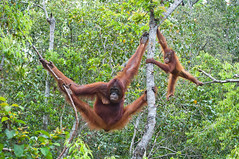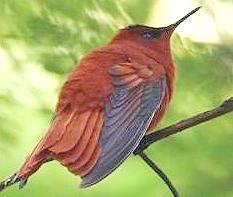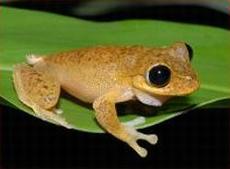國際保育科學家11日發表論文,首度指出一年投資800億美元,可以減緩所有瀕危物種的滅絕危機,也能保護全世界最重要的保育地區。
這項研究顯示,要避免人為引起的物種滅絕,以及改善全世界所有瀕危動植物的保育狀態,一年只需要一小部份的經費:47億6000萬美元。
主導該研究計畫的環境經濟學家麥卡錫(Donal McCarthy),是英國非營利組織「國際鳥盟」和英國皇家鳥類保護協會(RSPB)的成員。他表示:「全部所需的資金,不到全球消費者每年花費在無酒精飲料的20%。」
研究人員在10月8日~19日於印度海得拉巴市召開的「生物多樣性公約(CBD)締約方大會」裡提出這份報告,與會有160個國家從事生物多樣性保育的代表成員。
2010年各國政府在日本名古屋CBD研討會共同擬定2011年~2020年的生物多樣性策略目標,今年的任務,就是列出執行目標的步驟。
因為無法兌現先前減緩生物多樣性喪失速度的承諾,所以參與2010年CBD研討會的各國政府採用新策略計畫,也就是訂出20個在2020年要達到的「愛知目標」(Aichi Targets)。
新的策略計畫和20個愛知生物多樣性目標,也是聯合國系統架構下的生物多樣性任務。
過去兩年,各國按照在名古屋會議的承諾,已經更新國內的生物多樣性策略和行動計畫,以達成「愛知目標」。
 但是資金來源的協商仍懸而未決,該研究作者稱這是「對投資急迫度缺乏政治意志和充份資訊」。
但是資金來源的協商仍懸而未決,該研究作者稱這是「對投資急迫度缺乏政治意志和充份資訊」。
這項研究首次給出要達成兩項(也是作者認為最緊急的)愛知目標,所需經濟成本的權威資訊,這兩個目標是拯救瀕危物種和保護有保育用途的關鍵地區。
該文章發表在《科學》期刊,標題是「達成兩個全球生物多樣性保育目標的資金花費:投資現況與不足」,由國際鳥盟和RSPB(國際鳥盟在英國的合作機構)的科學家所撰寫。
該研究利用鳥類的數據(這是我們最了解的物種),來預測達到保育所有生物的目標所需經費。
世界自然保育聯盟(IUCN)發表的「瀕危物種紅皮書」裡檢視了6萬3837個物種,有1萬9817個瀕臨滅絕。
所有兩生類有41%是瀕危物種,而造礁珊瑚有33%,哺乳動物有25%,鳥類有13%,針葉樹則有30%瀕危。
 該論文作者預估未來10年,要降低全球所有瀕危鳥類的滅絕風險,每年要花費8億8000萬~12億3000萬美元,才足以在IUCN瀕危物種紅皮書中的級別獲得改善。
該論文作者預估未來10年,要降低全球所有瀕危鳥類的滅絕風險,每年要花費8億8000萬~12億3000萬美元,才足以在IUCN瀕危物種紅皮書中的級別獲得改善。
舉例來說,這意味讓一個物種的保育狀態,從「極危」改善為「瀕危」,或者從「易危」改善為「無危」。
然而,目前全世界只投入12%的經費。
麥卡錫表示,「我們點出經費不足,更清楚強化提高永續生物多樣性保育的迫切需求。」而「全部所需經費只是生態系統每年損失的淨價值(預估為2~6.6兆美元)的1~4%。」
國際鳥盟全球研究的召集人布查特(Stuart Butchart)說,「保育經費看似不少,但這是投資,不是花費。保護大自然符合經濟原則,因為人們從中得到了服務與利益,例如氣候變遷的改善與農作物的正常授粉。」
該研究由劍橋保育計畫(Cambridge Conservation Initiative)的共同保育基金(Initiative Collaborative Fund for Conservation)和阿卡狄亞(Arcadia)基金會資助,研究成果提供一個良好的基礎,幫助各國政府在2020年前執行CBD生物多樣性策略計畫過程裡,解決有關資金需求的各種爭論。

然而,交涉人員也面臨各國資源與生物多樣性存在差異的挑戰;較富有國家擁有更多資源,但富含生物多樣性且較具保育需求的國家卻缺乏資金。
布查特表示,「解決目前保育資金的危機非常迫切。我們越是延遲對保育的投資,所要投資的經費越多,也越難成功達成目標。」
全球政府都已承諾在2020年以前,增加受保護土地的面積,不過目前為止世界上最重要的自然區域,有一半是未保護的狀態。
IUCN的總幹事馬東拉菲(Julia Marton-Lefèvre)說:「我們在名古屋會議裡,為了拯救地球的生物多樣性,很有野心地通過新的(不過是很實際的)策略計畫。」「我們必須保持前進的動力。生物多樣性不斷流失,已經跨越『地球的限度』。現在正是嚴謹檢視我們的進展之時,好讓計劃真正付諸行動。」
CBD的執行秘書迪亞斯(Braulio Ferriera da Souza Dias)表示:「兩年前在名古屋,各國政府建立達成愛知目標的架構,自此我們已經在全世界看見實質的進展。這相當令人鼓舞,但是我們了解要實現策略目標的野心和達成愛知目標,還要付出更多努力。短期內它會受到資金不足的挑戰,然而,長期而言卻會帶來環境和社會利益。多數情況,這單純是考驗我們如何以不同方式運用現有資源。」
Investing US$80 billion a year would cut the risk of extinction for all threatened species and protect the most important global conservation sites, finds the first study of its kind, issued Thursday by an international team of conservation scientists.
To prevent human-driven extinction and improve the conservation status of all animal and plant species known to be globally threatened would cost just a fraction of the total – no more than US$4.76 billion annually, the study finds.
“The total required is less than 20 percent of annual global consumer spending on soft drinks,” said the paper’s lead author, Donal McCarthy, an environmental economist at the UK-based nonprofit BirdLife International and the Royal Society for the Protection of Birds.
The study was presented in Hyderabad to delegates from 160 governments working on biodiversity conservation at the Conference of the Parties to the Convention on Biological Diversity, CBD. The conference opened Monday and will run through October 19.
Governments are tasked with outlining the next steps needed to implement the Strategic Plan for Biodiversity 2011-2020, agreed two years ago at the CBD conference in Nagoya, Japan.
Following the failure of previous global commitments to even slow the rate of biodiversity loss, in 2010 all governments participating in the Convention on Biological Diversity adopted a new strategic plan – including 20 so-called Aichi Targets to be met by 2020.
The Strategic Plan and its 20 Aichi Biodiversity Targets are the agreed framework for biodiversity work in the United Nations system.
In line with their commitments in Nagoya, over the past two years, countries have been updating their national biodiversity strategies and action plans to achieve the Aichi Targets.
But financing negotiations are still unresolved due to what the study’s authors call “a lack of political will and patchy information on the investments needed.”
The new study contains the first authoritative information on the financial costs of meeting the two Aichi Targets that the authors consider most urgent: saving threatened species and protecting key sites for conservation.
Published in the journal Science, the paper, “Financial Costs of Meeting Two Global Biodiversity Conservation Targets: Current Spending and Unmet Needs,”
was written by a team led by scientists from UK-based BirdLife International and the Royal Society for the Protection of Birds, RSPB, which is the BirdLife affiliate in the UK.
The study uses data for birds, the best known class of organisms, to estimate the costs of meeting conservation targets for all of nature.
According to the Red List of Threatened Species maintained by the International Union for the Conservation of Nature, IUCN, out of the 63,837 species assessed, 19,817 are threatened with extinction.
This figure includes 41 percent of all amphibians, 33 percent of reef building corals, 25 percent of mammals, 13 percent of birds, and 30 percent of conifers.
The authors estimate it would cost between US$880 million and 1.23 billion annually over the next decade to reduce the extinction risk of all globally threatened bird species enough to show improvement by one category on the IUCN Red List of Threatened Species.
That would mean improving a species’ conservation status from Critically Endangered to Endangered, for instance, or from Vulnerable to Least Concern.
Just 12 percent of this funding is currently provided.
“The shortfalls we have identified highlight a clear and urgent need to scale up investment in biodiversity conservation substantially. The total costs are very small relative to the likely costs of inaction,” McCarthy said. “The total is just one to four percent of the net value of ecosystem services being lost annually, for which estimates range from $2 to $6.6 trillion.”
Dr. Stuart Butchart, BirdLife International’s Global Research Coordinator, said, “The total sums may sound large, but these are investments, not bills. “Saving nature makes economic sense because of the in terms of services and benefits that people receive in return, from mitigating climate change to pollinating crops.”
The analysis, funded by the Cambridge Conservation Initiative Collaborative Fund for Conservation and Arcadia, provides a sound basis for resolving the discussions among governments on the finance needed to implement the CBD Strategic Plan for Biodiversity up to 2020.
Negotiators are facing the challenge of addressing the current mismatch between the higher resources available in richer countries and the higher conservation needs in biodiversity-rich but financially poor countries.
“Resolving the on-going conservation funding crisis is urgent,” said Butchart. “The longer that investments in conservation are delayed, the more the costs will grow and the greater will be the difficulty of successfully meeting the targets.”
The world’s governments have committed to increasing the coverage of protected areas by 2020, but half of the world’s most important sites for nature are currently unprotected.
“In Nagoya, we agreed the Big Plan with ambitious yet realistic targets to save our planet’s biodiversity,” says Julia Marton-Lefèvre, IUCN Director General. “We need to keep the momentum going. Biodiversity loss continues and has breached safe planetary boundaries. It’s time for a serious check-up on progress we’ve made to turn the Big Plan into Big Action.”
“Two years ago in Nagoya, the world set a framework to achieve the Aichi Biodiversity Targets,” said Braulio Ferriera da Souza Dias, executive secretary of the Convention on Biological Diversity. “Since then we have seen significant progress around the world. This is encouraging but we know that we need to do more in order to realize the ambitions of the Strategic Plan and achieve the Aichi Targets. This will be challenging as it involves short term costs. However, the environmental and social benefits will be realized in the long term. Most of the time, this will simply mean spending existing resources in a different way.”
※ 全文及圖片詳見:ENS






